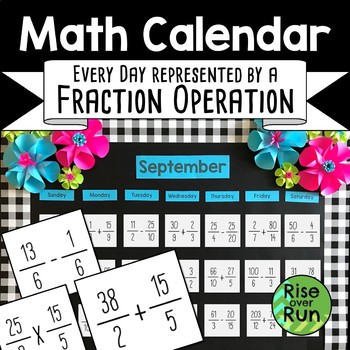Math Calendar Bulletin Board, Fraction Operations
Rise over Run
24k Followers
Grade Levels
4th - 7th
Subjects
Resource Type
Standards
CCSS4.NF.B.3a
CCSS5.NF.A.1
CCSS5.NF.B.4
CCSS6.NS.A.1
Formats Included
- Zip
Pages
60 pages
Rise over Run
24k Followers
Also included in
- Want to start every day with math? You need a math calendar! Every classroom should have one. Each day is represented by a math problem that students must solve to figure out the date. In this bundle, you will get 10 math calendars, each one based on a different math concept. Each one of thesePrice $24.99Original Price $49.90Save $24.91
Description
This math calendar is the perfect way for students to practice working with fractions daily.
This calendar requires no color ink. Print with black ink on any color paper.
Three sets of days (1-31) are included:
- Add and subtract fractions with common denominators
- Add and subtract fractions with unlike denominators
- Multiply and divide fractions
Improper fractions are included. Many of the problems involve fractions that are not reduced, so students may have multiple ways of solving. This can lead to some great discussions!
Months and days of the week are included in six font options.
All items are PDF format. Print the PDFs on 8.5x11 paper, cut out the pieces, laminate if you choose, and hang on a bulletin board or wall.
How some teachers use a math calendar:
- Talk about the daily problem as a part of morning math.
- Make arranging the calendar a math center at the beginning of each month.
- Use extra sets as task cards in a math station for early finishers.
- Display only the card for today's date on the main board.
- Simply as decoration that reinforces math skills!
Check out all my Math Calendars here.
Total Pages
60 pages
Answer Key
N/A
Teaching Duration
N/A
Report this resource to TPT
Reported resources will be reviewed by our team. Report this resource to let us know if this resource violates TPT’s content guidelines.
Standards
to see state-specific standards (only available in the US).
CCSS4.NF.B.3a
Understand addition and subtraction of fractions as joining and separating parts referring to the same whole.
CCSS5.NF.A.1
Add and subtract fractions with unlike denominators (including mixed numbers) by replacing given fractions with equivalent fractions in such a way as to produce an equivalent sum or difference of fractions with like denominators. For example, 2/3 + 5/4 = 8/12 + 15/12 = 23/12. (In general, 𝘢/𝘣 + 𝘤/𝘥 = (𝘢𝘥 + 𝘣𝘤)/𝘣𝘥.)
CCSS5.NF.B.4
Apply and extend previous understandings of multiplication to multiply a fraction or whole number by a fraction.
CCSS6.NS.A.1
Interpret and compute quotients of fractions, and solve word problems involving division of fractions by fractions, e.g., by using visual fraction models and equations to represent the problem. For example, create a story context for (2/3) ÷ (3/4) and use a visual fraction model to show the quotient; use the relationship between multiplication and division to explain that (2/3) ÷ (3/4) = 8/9 because 3/4 of 8/9 is 2/3. (In general, (𝘢/𝘣) ÷ (𝘤/𝘥) = 𝘢𝘥/𝘣𝘤.) How much chocolate will each person get if 3 people share 1/2 lb of chocolate equally? How many 3/4-cup servings are in 2/3 of a cup of yogurt? How wide is a rectangular strip of land with length 3/4 mi and area 1/2 square mi?






